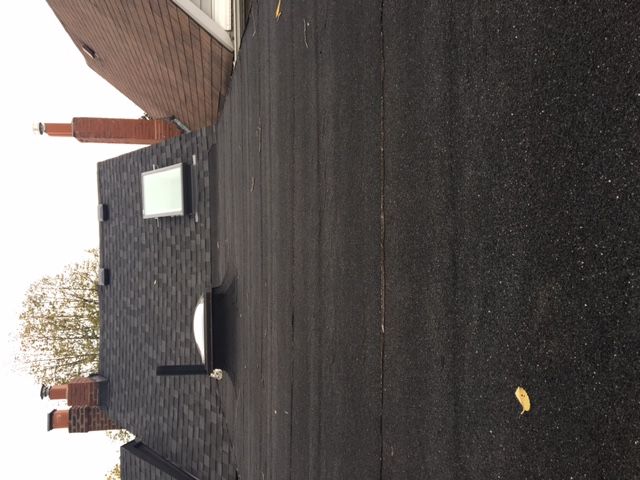Hi all, I just registered today! Some of the roofing material on my low-slope roof is starting to peel up from the drip edge as shown in the pics. I’m wondering:
1. What is the proper name for this type of roofing product?
1. What would be the proper product to use to “glue” it back down?
3. Is it any use in trying to glue it down, or am I just trying to fill the gap that is now exposed? I’m not sure how old the roof is, but it’s generally in pretty good shape. Pretty stiff material though.




Thanks!























Replies
Uh, what "drip edge"? The
Uh, what "drip edge"? The roofing material should extend 1-2 inches past the edge of the fascia flashing, in which case the situation you show would no be a problem at all. As it is, it's hard to say, as the roofing may or may not be fastened down further back from the edge.
Well I have seen what you are calling "fascia flashing" referred to as "drip edge" several times. Regardless, I had a (well-reviewed) roofing company do an inspection and one item that they came back with was that the membrane was separated at the roof edge. While I can see how extending the material beyond the edge would work, they gave no indication that it was installed incorrectly.
*Edit* Oh I may see the difference between drip edge and fascia flashing now... The flashing that was used doesn't have a bend that jutts out from the fascia. I would not be shocked if the wrong flashing was used and the roof inspection didn't pick that up.
Gutter apron and/or ODE
I think the correct name for the flashing is "Gutter Apron". Regardless of whether is ought to have been ODE (overhang drip edge), the main point is that it provides a sound base for sealing the edges of the roof membrane. I see delamination. One cause for this may be ice dams in the gutter. There are other reasons I can think of. Regardless, my suggesting is to use a high-grade, glue-like caulk such as Lexel. Run a thick bead under each trouble spot and weigh down the membrane with bricks. Try to do this when the temp is warm. Lexel will cure in colder weather, but the membrane may not be as flexible then as it is in the warmer months.
One more thing: water can "climb up" the edge of the membrane due to capillary action. As others have noted, it would have been nice if the membrane protrudes a bit beyond the gutter apron. On the other hand, such a protrusion is likely to weather and crack over time (since it is unsupported underneath)
Mel froscarpentry.com
Very helpful reply! I don't see Lexel available at my local Home Depot... What do you think about this?
https://www.homedepot.ca/en/home/p.300ml-black-polyurethane-waterproof-roof-and-flashing-sealant.1000417171.html
Polyurethane based "black jack" lacks the adhesive strength you need for your repair. It might work...I don't use polyu for anthing other than spot-covering exposed nails (which is rather rare).
I've been around many, many years, and clear Lexel remains my 1st choice for this particular application. Not knowing if, in fact, your have an EPDMembrane on your roof, I can't make any other recommendation. Lexel glues and then somel...but be sure to weight down the repaired spots. Don't be too hasty to remove the weights, since the old Mann Winter is around the corner and Lexel may take a tad longer to firm up in cold weather. It MUST firm up or else delamination may happen all over and this time around you will be sorely pressed to removed the semi-cured Lexel. Lexel is sold at Do It Best and, as I recall, Ace Hardware stores. It's expen$ive at nearly $10 a pop!
Mel froscarpentry.com
That looks like granulated 90# rool roofing which is usually hot moped down with liquid asphalt. Obviously got thin at the edges. I'd lift the loose spots as much as possible and squeeze as much flashing cement under as you can then lay a brick or something else heavy for a few days to force it down. I'd even nail it with roofing nails if there is wood under it. The flashing cement comes in caulk tubes.
Thanks for the great reply! Is this product a type of roofing cement that you would recommend?
https://www.homedepot.ca/en/home/p.300ml-black-polyurethane-waterproof-roof-and-flashing-sealant.1000417171.html
Is is granulated 90 lb roofing
I just want to observe that a roof I am working on as I write has an EPDMembrane by Tampko that is granulated and looks very much like it's mineral-surfaced cousin. The two materials are very different...but may respond well to the same glue-like material used to make repairs. Sorry I can't say more.
Mel (licensed IL roofer/remodeler for far too many years to count :)
I just added a couple more pics (can't seem to make them right-side-up unfortunately!) and have one more question - there seems to be gravel stops installed on the edge of my roof, but there is no gravel. Is this done correctly? I suppose it could be to channel water to the low edge to avoid installing gutters on the sides of the roof. Any opinions on this?
Look closely at what appears to be an L-shaped gravel ledge (flashing) and determine if it is something left over from the original gravel-and-tar roof. If it is, you should be seeing black tar spots on the flashing. Don't try to remove it at this time since your current roofing material lies on top. Make sure water can't get behind and under the area where the existing membrane and L-shaped flashing iinterface. Lexel may be needed in spots or along the whole run of flashing.
Good luck Mel